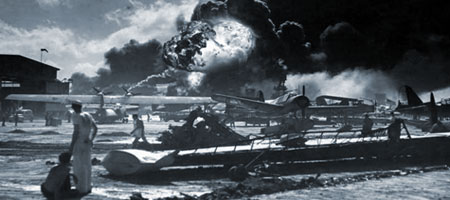Pearl Harbor: The Complexities of December 7, 1941

The day before the Japanese attacked Pearl Harbor and other American and British bases in the Pacific, polls showed that 80 percent of the American people opposed engagement in war in the Pacific or in Europe. The country looked inward, preoccupied with the economic and social crises of the Great Depression.
Memory and history of Pearl Harbor combine to give us conflicting views of the attack—and an opportunity to emphasize critical thinking skills in the classroom through exploring diverse historical perspectives, analyzing causes, and evaluating the inevitability of the attack. Much of the controversy and debate centers around what factors led the Japanese to bomb Pearl Harbor or whether President Roosevelt knew about the attack before it occurred.
Recently in the New York Times, the son of one of the soldiers who raised the flag on Iwo Jima looked for answers to the question "...why did we fight in the Pacific? Yes, there was Pearl Harbor, but why did the Japanese attack us in the first place?" Author James Bradley finds causal roots, not with President Franklin Roosevelt's Asian policy, but earlier in the century with President Theodore Roosevelt's actions to devise a secret alliance with Japan promoting Japanese hegemony in Asia. But the Japanese chafed under Roosevelt's terms for this covert support, and their dissatisfaction was later manifest in their Declaration of War. Bradley claims, "...the American president’s support emboldened them to increase their military might — and their imperial ambitions."
At History News Network, various historians offer their perspective on Pearl Harbor antecedents. A Date Which Will Live in Infamy links to various sources documenting U.S. provocation of Japan. Author of the book, A Date Which Will Live: Pearl Harbor in American Memory, Professor Emily Rosenberg describes the echo of Pearl Harbor in public response to September 11 terrorist attacks. "'Infamy' framed the first representations of September 11. That word, which since 1941 had become a virtual synonym for the Pearl Harbor attack, was culturally legible to almost everyone. It invoked a familiar, even comforting, narrative: a sleeping nation, a treacherous attack, and the need to rally patriotism and 'manly' virtues on behalf of retribution. "
First Lady Eleanor Roosevelt addressed the nation the day before the President issued a Declaration of War. Mrs. Roosevelt's regular weekly radio broadcast fell on December 7, and her words encouraged bravery and determination in the face of the certainty of war. "Whatever is asked of us I am sure we can accomplish it. We are the free and unconquerable people of the United States of America." The Eleanor Roosevelt Papers Project provides a lesson plan applicable for middle and high school students, Case Study: Eleanor Roosevelt’s Radio Broadcast on December 7, 1941.
On December 8, at 12:30 p.m., Roosevelt addressed a joint session of Congress and the Nation via radio. In his first draft of the address, President Roosevelt called December 7 "a date that will live in history." But as he edited the six-minute radio address—a simple, uncomplicated appeal to the people of the United States—he strengthened his language and tone. "A Date Which Will Live in Infamy" is now a phrase that lives in history.
Roosevelt's annotated copy of the Declaration of War, sound recordings of the radio broadcast, and lesson plans are available online at the National Archives. Interestingly, Roosevelt left his copy of the speech on the floor of the Senate, and for 43 years it lay buried, lost among other Senate records. Lesson plans ask students to look at the language of the speech and to compare it with Patrick Henry's "Liberty or Death" speech before the Virginia Convention in 1775.
The National World War II Museum guides teachers through methods and materials for teaching about Pearl Harbor. Other Lesson Plans for Teachers give educators guidelines to consider as you teach about World War II. A hands-on geography lesson, specifically designed for fifth through eighth graders incorporates Google maps to give students a sense of the scope and players in World War II. (Classroom internet connection required, and directions are clear for this interactive project.)
The museum also offers videoconferenced virtual field trips, and Curator Kenneth Hoffman explains the what they are and how to arrangeme them for your class.
The Naval History & Heritage Command features a historical overview and special image selection on the Pearl Harbor raid with links to more comprehensive archival materials.
Check our earlier blog post on Veterans, Oral History, and the Library of Congress focusing on the Veterans History Project (VHP) at the LOC.
Read website review of After the Day of Infamy: "Man on the Street" Interviews Following the Attack on Pearl Harbor, more than 12 hours of audio interviews with 200 Americans from 10 locations across the United States.
For older students, follow the review of to hear a webcast from the Library of Congress on events leading up to Pearl Harbor. Historian, economist, and author Ed Miller discusses his award-winning book Bankrupting the Enemy: The U.S. Financial Siege of Japan Before Pearl Harbor. Miller contends that the Japanese motivation stemmed from U.S. plans to defeat Japan economically in the years before World War II.
And an Ask-a-Historian question plays the game of alternative history in response to "If America had opened its ports at Pearl Harbor and the Philippines to the Russians prior to 1941, do you think that might have delayed or caused the Japanese to think twice about attacking these places?"